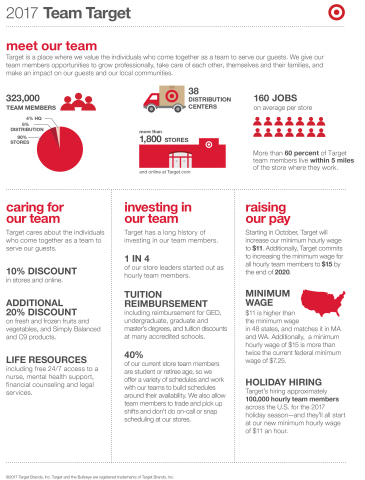MINNEAPOLIS--(BUSINESS WIRE)--Target Corporation (NYSE: TGT) today announced plans to raise its minimum hourly wage for all team members to $11 in October, along with a commitment to increasing the minimum hourly wage to $15 by the end of 2020. This significant investment in its team will allow Target to continue to recruit and retain strong team members and provide an elevated experience for its guests and in the communities it serves.
“Target has a long history of investing in our team members. We care about and value the more than 323,000 individuals who come together every day with an absolute commitment to serving our guest,” said Brian Cornell, CEO and chairman of Target. “Target has always offered market competitive wages to our team members. With this latest commitment, we’ll be providing even more meaningful pay, as well as the tools, training and support our team needs to build their skills, develop professionally and offer the service and expertise that set Target apart.”
By moving to an $11 minimum hourly wage this fall, Target will provide pay increases to thousands of team members across the country before the holiday season. This increase will also apply to the more than 100,000 hourly team members that Target is hiring for the holiday season. The commitment to move to a minimum hourly wage of $15 will be implemented between now and the end of 2020.
Investing in its Team
On average, Target employs 160 team members per store and offers career planning and development opportunities, with one in four of our store leaders having come from hourly positions within a Target store. Also, more than 60 percent of Target team members live within five miles of the store where they work. Target has been recognized for its efforts to invest in its team, including ranking on Fortune’s list of the World’s Most Admired Companies and DiversityInc’s list of Top Companies for Diversity and being named one of the Top 50 Companies for Executive Women.
Target currently pays market competitive rates above the federal minimum wage at all stores nationwide. Target’s last major wage increase was in 2016, when the company moved to a $10 minimum hourly wage. A minimum hourly wage of $11 is higher than the minimum wage in 48 states, and matches the minimum wage in Massachusetts and Washington. Additionally, Target offers a variety of schedules to meet the needs of its diverse population and works with its teams to build schedules around their availability. With input from its team members, Target posts store schedules in advance, allows store team members to trade and pick up shifts at their store location, and doesn’t do on-call or snap scheduling at its stores.
Target offers a number of benefits for its team members, including a 10 percent merchandise discount at Target and Target.com and an additional 20 percent health and wellness discount on fresh fruits and vegetables, all Simply Balanced products and C9 merchandise. Comprehensive health and wellness programs are available for eligible team members, including healthcare benefits, paid parental leave, paid short-term disability and free access to life resources such as nurse, mental health support, financial counseling and legal services. The company also offers financial resources for its team members, including Target Credit Union, a dollar-for-dollar 401(k) match for eligible team members, tuition reimbursement for GED, Undergraduate, Graduate and Masters Degrees and tuition discounts at many accredited schools.
Guidance Update
Target today reiterated its most recent sales and EPS guidance for third quarter and full year 2017. Consistent with the Company’s second quarter 2017 earnings release, Target expects both third quarter and fourth quarter 2017 comparable sales growth will be within the range the Company experienced in the first and second quarters of 2017, and expects its full-year 2017 comparable sales growth will be in a range around flat, plus or minus 1 percent.
For third quarter 2017, the Company continues to expect both GAAP EPS from continuing operations and Adjusted EPS of $0.75 to $0.95. For full-year 2017, the Company continues to expect GAAP EPS from continuing operations of $4.35 to $4.55, and Adjusted EPS of $4.34 to $4.54. The 1 cent difference between the full-year guidance ranges for GAAP EPS from continuing operations and Adjusted EPS is due to the income tax matters excluded from Adjusted EPS in the first half of the year.
Third quarter and full-year 2017 GAAP EPS from continuing operations may include the impact of additional discrete items which will be excluded in calculating Adjusted EPS. The only additional discrete item of which the Company is aware is a possible net benefit from income tax matters not related to current period operations in an amount that cannot presently be estimated.
Miscellaneous
Statements in this release regarding third quarter, fourth quarter and full-year 2017 earnings per share and comparable sales guidance are forward-looking statements within the meaning of the Private Securities Litigation Reform Act of 1995. Such statements are subject to risks and uncertainties which could cause the Company’s actual results to differ materially. The most important risks and uncertainties are described in Item 1A of the Company’s Form 10-K for the fiscal year ended Jan. 28, 2017. Forward-looking statements speak only as of the date they are made, and the Company does not undertake any obligation to update any forward-looking statement.
About Target
Minneapolis-based Target Corporation (NYSE: TGT) serves guests at 1,816 stores and at Target.com. Since 1946, Target has given 5 percent of its profit to communities, which today equals millions of dollars a week. For more information, visit Target.com/Pressroom. For a behind-the-scenes look at Target, visit Target.com/abullseyeview or follow @TargetNews on Twitter.

